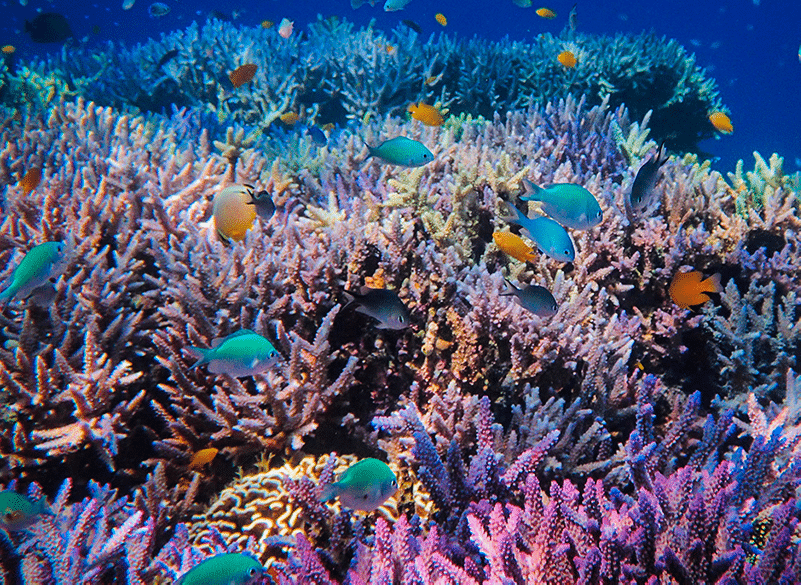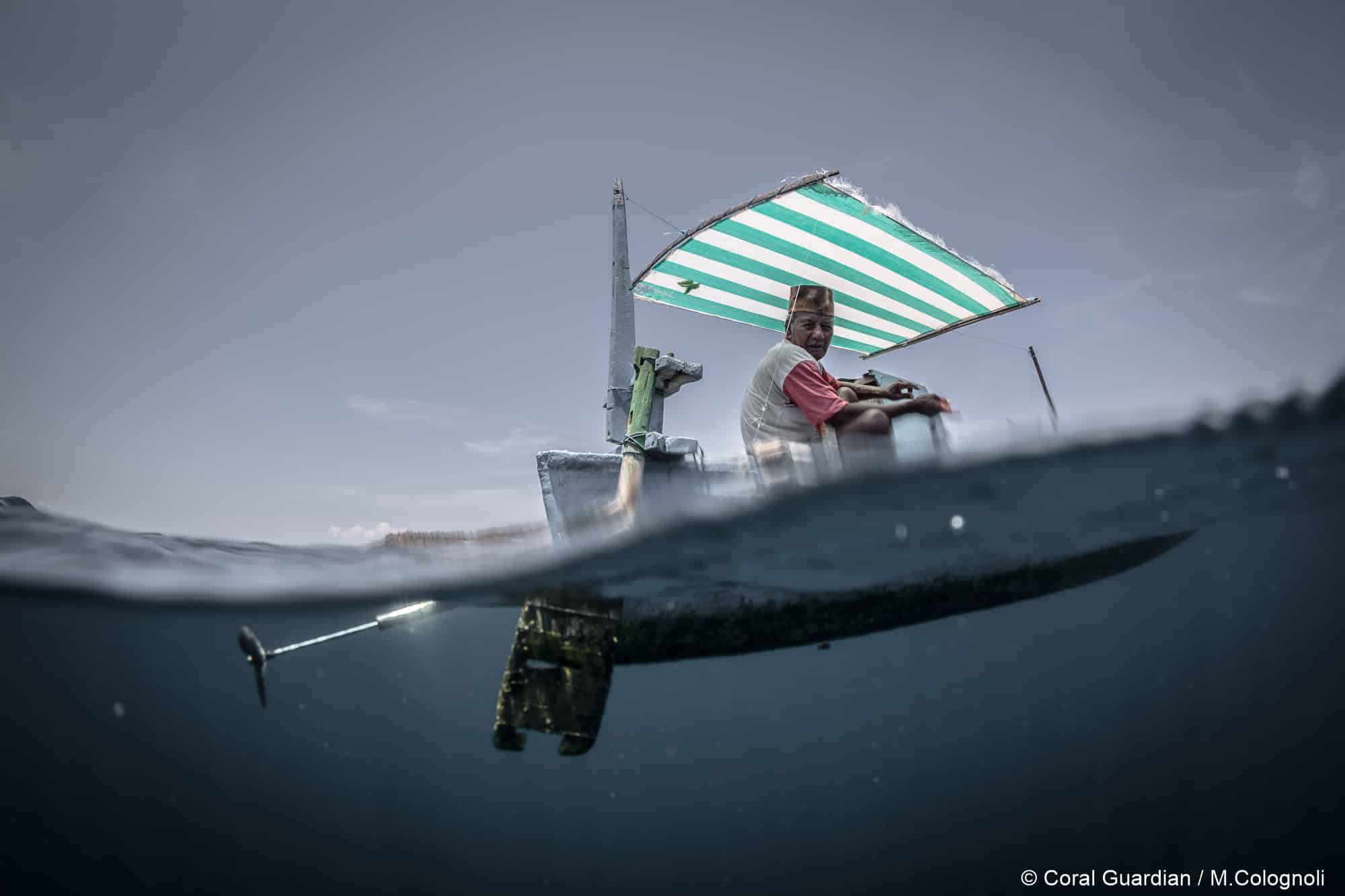Carbon balance in corals

Written by Jeanne Kault, Florina Jacob and Olivier Detournay.
Acknowledgments to Eric Röttinger.
Coral reefs cover an area of 284,300 km2 (Spalding et al., 2001), less than 0.1% of the ocean’s surface area. Yet, they are among the most diverse ecosystems, hosting thousands of species of organisms.
When considering the current climate challenges, as well as the huge storage and release of carbon by the oceans, questions about the role of coral reefs in the carbon balance arise. Corals are able to capture, release and accumulate carbon in different forms (HCO3–, CO2, CaCO3…) and through multiple mechanisms, such as photosynthesis performed by their zooxanthellae, cellular respiration and calcification.
To determine corals’ carbon balance, one way is to consider the difference between the quantities of absorbed and released carbon during corals’ metabolism (Tambutté et al., 2011).
On one hand, there is the carbon fixed during zooxanthellae’s photosynthesis, as well as during skeleton formation in the form of calcium carbonate (CaCO3). On the other hand, some carbon is released in the form of carbon dioxide (CO2) through coral respiration and the calcification process.
The quantity of carbon fixed through photosynthesis is approximately the same as the one released by corals’ respiration. Therefore, the net effect of the carbon involved in these processes is estimated to be near zero (Frankignoulle and Gattuso, 1993). So, in order to simplify the present discussion, we will focus on the captured and released carbon through the formation and accumulation of corals’ skeletons.
Corals: carbon sinks (C) and sources of carbon dioxide (CO2)
Coral calcification (or skeleton formation in CaCO3) releases CO2 by hydrogen ions’ evacuation (for more details click here). When one unit (called “mole” in chemistry) of CaCO3 is produced by calcification, 0.6 units of CO2 are released in the water column (Ware et al., 1992).
This value is an estimation, and it can vary according to different factors such as the species’ composition and abundance in the reef community (Tunnicliffe, 1983; Kayanne et al., 1995), coral cover, amongst other factors (Tambutté et al., 2011).
On the field, measures were taken on a reef in Moorea, considered as a reef of reference (Gattuso et al.,1993 ; Tambutté et al., 2011). Here, the rate of CO2 released by the reef was estimated at 1.5 mmol/m2 per day. If we use these results to estimate a global approximation, we obtain the equivalent of 155.65 Gigamoles CO2/year emitted by coral reefs (Spalding et al., 2001). Consequently, reefs mainly dominated by corals are a source of CO2 (Allemand, 2019). Considering only the carbon portion present in CO2, carbon emissions due to the calcification process of global coral reefs is estimated at 1.86 Megatons of carbon per year (1 mole CO2 = 44 g) during CO2.
Yet coral reefs are also able to accumulate and stock carbon continuously in the form of CaCO3 which form their calcareous skeleton. According to Frankignoulle & Gattuso’s (1993) work, it is estimated that coral reefs represent a carbon sink of almost 70 to 90 Megatons of carbon per year.
To sum up, according to these estimations, coral reefs release 1.86 Megatons of carbon per year by means of calcification, but they are also capable of storing between 70 to 90 Megatons of carbon per year by CaCO3 accumulation in their skeleton. Based on this information, carbon net storage by coral reefs is between 68.14 and 88.14 Megatons of carbon per year considering both the released CO2 and the stocked CaCO3 involved in the formation and accumulation of coral skeleton. Again, this is an approximation based on reference values, and may differ for each ecosystem, as mentioned above.
What happens to the carbon absorbed and accumulated by corals?
A large part of the carbon will form the framework of coral reefs by continuous accumulation of the calcareous skeleton. The future of this true carbon sink is still relatively poorly understood. A part of it will constitute the coral reefs’ framework (gray arrow, Figure 1A); another part will be reintroduced in the trophic chain through bioerosion (f.e. the scraping and boring action of coral skeletons by reef organisms; green arrow, Fig 1A). Finally, some amount will be released into the water by natural/chemical dissolution (black arrow, Fig 1A).
Ocean acidification linked to the human-driven increase of atmospheric CO2 jeopardizes the equilibrium between these processes (see our article on the subject). A higher amount of CO2 in the atmosphere implies a greater absorption by the oceans, leading to an increase in the amount of hydrogen ions present in the water. The more hydrogen ions there are, the more acidic the environment will be, interfering with the mechanisms involved in the calcification. The result is a reduced calcification (orange arrow, Fig 1B), an increased coral dissolution (black arrow, Fig 1B) and overall erosion of biodiversity.


Figure 1. Simplified scheme of carbon exchanges within coral reefs in the baseline scenario (A, top) and in an oceans’ acidification scenario (B, bottom). Arrows show the direction of carbon release and capture in each biological process. Source: Coral Guardian.
Conclusion
These estimates of carbon balance in coral reefs point to them as carbon sinks. Even if they release CO2, corals are able to accumulate more carbon in the form of calcium carbonate (CaCO3) in their calcareous skeletons. However, the formation and accumulation of coral reefs’ skeletons is undermined by ocean acidification due to climate change, which accelerates the dissolution of skeletons and slows down the calcification process, threatening the framework of an entire ecosystem.
Nonetheless, it is important not to reduce coral reefs value to simply carbon stocks or sources. They host a huge biodiversity and they offer coastal protection, while supporting economical activities to human communities directly or indirectly. The common challenge of climate change, with ocean acidification and temperature increase, amongst other factors, modify their functions rapidly and force us to improve our comprehension of these processes, to adapt our measures to these changes and to change our habits on a daily basis.
Find out more:
Allemand, D. (2019). Les coraux et le changement climatique. Océan et Climat – Fiches scientifiques, p.3649. Available on: https://ocean-climate.org/wp-content/uploads/2019/09/Fiches-scientifiques-2019.pdf
Frankignoulle, M., & Gattuso, J.-P. (1993). Air-Sea CO2 Exchange in Coastal Ecosystems. In R. Wollast, F. T. Mackenzie, & L. Chou (Éds.), Interactions of C, N, P and S Biogeochemical Cycles and Global Change (p. 233248). Springer. https://doi.org/10.1007/978-3-642-76064-8_9
Gattuso, J.-P., Pichon, M., Delesalle, B., & Frankignoulle, M. (1993). Community metabolism and air-sea CO2 fluxes in a coral reef ecosystem (Moorea, French Polynesia). Marine Ecology Progress Series, 96, 259267. https://doi.org/10.3354/meps096259
Gattuso, J.-P., Frankignoulle, M., & Smith, S. V. (1999). Measurement of community metabolism and significance in the coral reef CO2 source-sink debate. Proceedings of the National Academy of Sciences of the United States of America, 96(23), 1301713022.
Kayanne, H., Suzuki, A., & Saito, H. (1995). Diurnal changes in the partial pressure of carbon dioxide in coral reef water. Science (New York, N.Y.), 269(5221), 214216. https://doi.org/10.1126/science.269.5221.214
Spalding M.D., Ravilious C., Green E.P. (2001) World Atlas of Coral Reefs. Prepared at the UNEP World Conservation Monitoring Center. University of California Press. Berkley, USA. Site internet : https://archive.org/details/worldatlasofcora01spal/page/2/mode/2up
Tambutté S., Holcomb, M. Ferrier-Pagès C., Reynaud S., Tambutté E., Zoccola D., & Allemand D. (2011). Coral biomineralization: From the gene to the environment. Journal of Experimental Marine Biology and Ecology, 408(12), 5878. https://doi.org/10.1016/j.jembe.2011.07.026
Tunnicliffe, V. (1983). Caribbean Staghorn Coral Populations : Pre-Hurricane Allen Conditions in Discovery Bay, Jamaica. Bulletin of Marine Science, 33(1), 132151.
Ware J. R., Smith S. V. & Reaka-Kudla M. L., 1992. Coral reefs: sources or sinks of atmospheric CO2? Coral Reefs 11:127-130.


